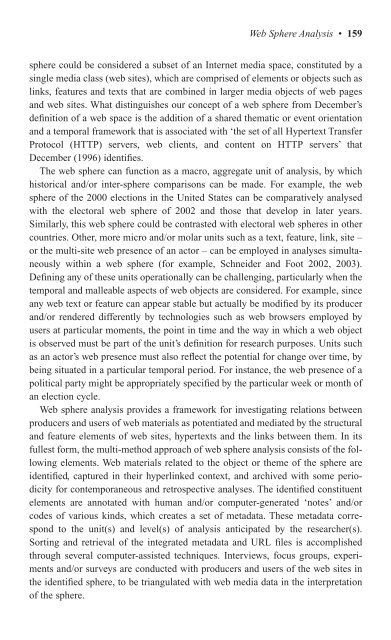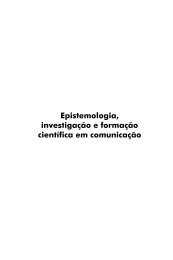Virtual Methods
Virtual Methods
Virtual Methods
Create successful ePaper yourself
Turn your PDF publications into a flip-book with our unique Google optimized e-Paper software.
Web Sphere Analysis • 159<br />
sphere could be considered a subset of an Internet media space, constituted by a<br />
single media class (web sites), which are comprised of elements or objects such as<br />
links, features and texts that are combined in larger media objects of web pages<br />
and web sites. What distinguishes our concept of a web sphere from December’s<br />
definition of a web space is the addition of a shared thematic or event orientation<br />
and a temporal framework that is associated with ‘the set of all Hypertext Transfer<br />
Protocol (HTTP) servers, web clients, and content on HTTP servers’ that<br />
December (1996) identifies.<br />
The web sphere can function as a macro, aggregate unit of analysis, by which<br />
historical and/or inter-sphere comparisons can be made. For example, the web<br />
sphere of the 2000 elections in the United States can be comparatively analysed<br />
with the electoral web sphere of 2002 and those that develop in later years.<br />
Similarly, this web sphere could be contrasted with electoral web spheres in other<br />
countries. Other, more micro and/or molar units such as a text, feature, link, site –<br />
or the multi-site web presence of an actor – can be employed in analyses simultaneously<br />
within a web sphere (for example, Schneider and Foot 2002, 2003).<br />
Defining any of these units operationally can be challenging, particularly when the<br />
temporal and malleable aspects of web objects are considered. For example, since<br />
any web text or feature can appear stable but actually be modified by its producer<br />
and/or rendered differently by technologies such as web browsers employed by<br />
users at particular moments, the point in time and the way in which a web object<br />
is observed must be part of the unit’s definition for research purposes. Units such<br />
as an actor’s web presence must also reflect the potential for change over time, by<br />
being situated in a particular temporal period. For instance, the web presence of a<br />
political party might be appropriately specified by the particular week or month of<br />
an election cycle.<br />
Web sphere analysis provides a framework for investigating relations between<br />
producers and users of web materials as potentiated and mediated by the structural<br />
and feature elements of web sites, hypertexts and the links between them. In its<br />
fullest form, the multi-method approach of web sphere analysis consists of the following<br />
elements. Web materials related to the object or theme of the sphere are<br />
identified, captured in their hyperlinked context, and archived with some periodicity<br />
for contemporaneous and retrospective analyses. The identified constituent<br />
elements are annotated with human and/or computer-generated ‘notes’ and/or<br />
codes of various kinds, which creates a set of metadata. These metadata correspond<br />
to the unit(s) and level(s) of analysis anticipated by the researcher(s).<br />
Sorting and retrieval of the integrated metadata and URL files is accomplished<br />
through several computer-assisted techniques. Interviews, focus groups, experiments<br />
and/or surveys are conducted with producers and users of the web sites in<br />
the identified sphere, to be triangulated with web media data in the interpretation<br />
of the sphere.



